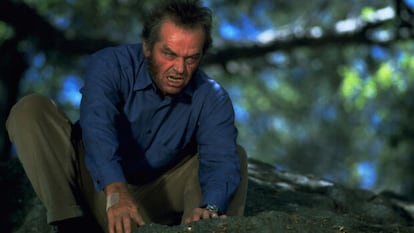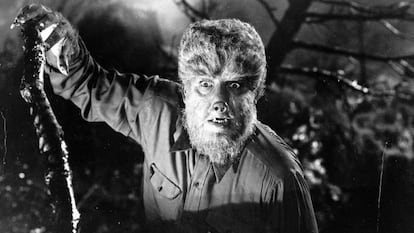The werewolf still walks among us
The anthropologist Roger Bartra examines the metamorphoses of the myth of the wild lycanthrope, a 4,000-year-old legend born to ‘identify the civilized’


The werewolf, a beast that pretends to be human but under a full moon gives free rein to its ferocity, to a cruelty that knows nothing but instinct, a murderous and ungovernable impulse, was not always a monster. It was born as a myth of the savage — the man out of control, uncivilized — as a metaphor to “identify the civilized” from its opposite, to outline “the security of the known environment” and, going even further, “to represent evil to, by contrast, delineate good or goodness.” And how has the werewolf survived and evolved from its first recorded mention circa 2,000 B.C. in the Epic of Gilgamesh to the latest incarnation of the myth in the television series Wolf Like Me?
Anthropologist Roger Bartra, one of Latin America’s leading social scientists and an expert on mythology, has published an exhaustive compilation essay on the subject, entitled simply El mito del hombre lobo (or, The myth of the werewolf). In it, he inventories every form that the myth has taken in fiction and thought. The werewolf is born as a victim, created by no less a woman than Ishtar, the Mesopotamian goddess of fertility, love, and war — a lover of men and animals alike — who condemns her shepherd suitor to live as a wolf. “It is she and not her victims - she has already turned a gardener into a frog, set a trap for the lion, condemned the horse to ride without rest - who embodies evil,” according to Bartra, who points out, however, that it did not take long for that to change.

“Evil exists only as an idea. Religion considers it, since the time of St. Thomas and St. Augustine, as the absence of good. But at the popular level, evil needs to exist as something alien: someone must incarnate it in order to redeem it,” the anthropologist tells EL PAÍS via video call. That is why today, Bartra says, and since that long-distant first appearance, the werewolf is considered as part of “the myth of the wild man,” that uncontrolled being of violent animal drive, “an incarnation of evil.” In antiquity — around the second century A.D. — lycanthropy became a form of madness. The “patient” dug up bones from cemeteries “and, howling, carried them through the streets,” and Bartra explains the survival of the myth through its metamorphic and cyclical condition.
During the Middle Ages this powerful figure, somewhere between romantic and cursed, appears in numerous poems and romances, even in penitential texts — if a man was accused of being a werewolf he was burned at the stake like a witch, and there are testimonies of people accusing neighbors with no more proof than hearsay — as well as in travel books. “I have tried to rescue the stories from their context and pursue the myth in its various historical appearances,” says Bartra. This allows for comparisons across time, such as the one that says “Prince Vseslav of Polotsk, that legendary werewolf who besieged Kyiv in the 11th century and was defeated at the battle on the Nemiga River,” could have “his evil replica in the autocrat Vladimir Putin in the 21st century.”

In children’s fairytales, before Charles Perrault and the Brothers Grimm, wolves were werewolves. “It is evident, in the case of Little Red Riding Hood, that the wolf is a man and that what he cannot repress is desire,” notes Bartra, who explains that, at a certain point, the adolescent girl became the center of the tale, a tale that until then had been aimed at controlling male desire. “It is clearly linked to the idea of the male, to male violence, but it goes far beyond that,” he adds. And yet the myth, in the contemporary world, prefers to dismantle even that idea. Wolf Like Me, for example, presents female lycanthropy as a hidden and unbearable yet fierce and savage self.
“Of course, because of its condition, the myth adapts to each era and tries to explain it, or it is the era that tries to explain itself through the myth,” says the anthropologist, for whom the perfect literary incarnation of the werewolf remains Robert Louis Stevenson’s classic The Strange Case of Doctor Jekyll and Mr. Hyde, which was published at a time when the myth was in decline “because of the morals that came out of the 19th-century stories,” which were more interested in lecturing than in questioning the duality of human condition, something that Stevenson was able to take to a peak of his own that almost annulled the idea of the werewolf throughout the 1800s.

Would Bartra say that the werewolf has become a forgotten myth today? “No, not at all. As a myth it will always be there. Of course, we no longer believe that werewolves exist as the peasants of the Middle Ages did and as had been believed up until then, but we play on their symbolic power to still identify the civilized,” he says. From the packs of male and female wolves in True Blood, the television series based on the novels of Charlaine Harris — wild, but at the same time, because of their canine condition, faithful and loyal — to the powerful and neurotic and funny, though in many ways wounded, stranger that bursts into the life of the father and daughter protagonists of Wolf Like Me, the myth is still growing and evolving to try to continue to fit into the world.
Sign up for our weekly newsletter to get more English-language news coverage from EL PAÍS USA Edition
Tu suscripción se está usando en otro dispositivo
¿Quieres añadir otro usuario a tu suscripción?
Si continúas leyendo en este dispositivo, no se podrá leer en el otro.
FlechaTu suscripción se está usando en otro dispositivo y solo puedes acceder a EL PAÍS desde un dispositivo a la vez.
Si quieres compartir tu cuenta, cambia tu suscripción a la modalidad Premium, así podrás añadir otro usuario. Cada uno accederá con su propia cuenta de email, lo que os permitirá personalizar vuestra experiencia en EL PAÍS.
¿Tienes una suscripción de empresa? Accede aquí para contratar más cuentas.
En el caso de no saber quién está usando tu cuenta, te recomendamos cambiar tu contraseña aquí.
Si decides continuar compartiendo tu cuenta, este mensaje se mostrará en tu dispositivo y en el de la otra persona que está usando tu cuenta de forma indefinida, afectando a tu experiencia de lectura. Puedes consultar aquí los términos y condiciones de la suscripción digital.
More information
Archived In
Últimas noticias
Most viewed
- Alain Aspect, Nobel laureate in physics: ‘Einstein was so smart that he would have had to recognize quantum entanglement’
- The US bombing of Venezuela, in pictures
- Oil, gold and rare earth elements: the backdrop to US political tension with Venezuela
- Maps of the US attack on Venezuela: Targets, airspace and deployed fleet
- Delta Force, the elite US military unit that captured Maduro










































